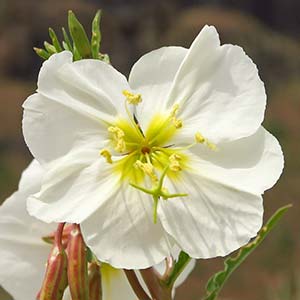Oenothera deltoides
Oenothera pallida
pale evening-primrose
Leaves alternate, liner to liner-lanceolate, 2-6 cm. long and up to 5 mm. broad, entire to serrate, occasionally with 1 or more basal lobes, narrowed to broad petioles 5-15 mm. long.
Flowers fragrant, in leafy spikes, the buds nodding;
calyx tube 1.5-3.5 cm. long, pink to purplish, the 4 lobes reflexed, 1-4 cm. long, fused and turned to one side;
petals 1.5-3 cm. long, white, aging pinkish, obovate;
stamens 8, equal to the petals;
stigma with 4 linear lobes 4-6 mm. long;
ovary inferior, 4-celled.
Capsule liner, 2-3 mm. thick at the base, tapering to the tip, 1.5-3.5 cm. long, arched.
Oenothera deltoides
Oenothera pallida
Occurring east of the Cascades crest in Washington; British Columbia to Arizona, east to the Rocky Mountains and Texas.


